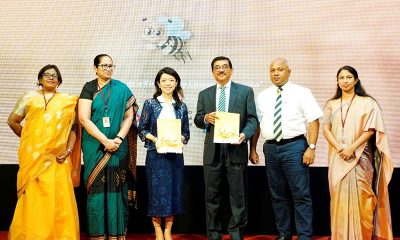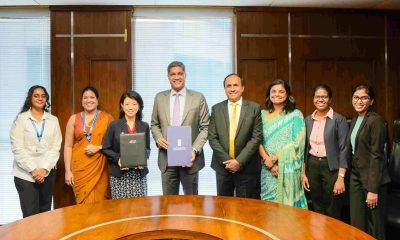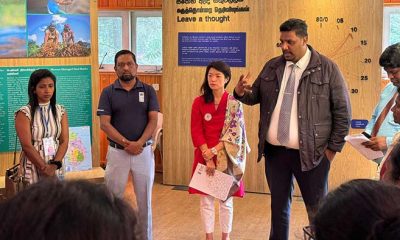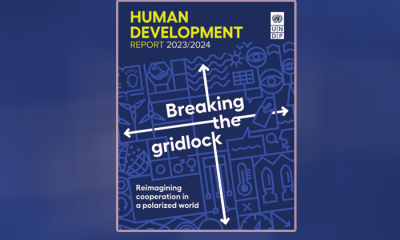Business
UNDP working directly with vulnerable communities and families
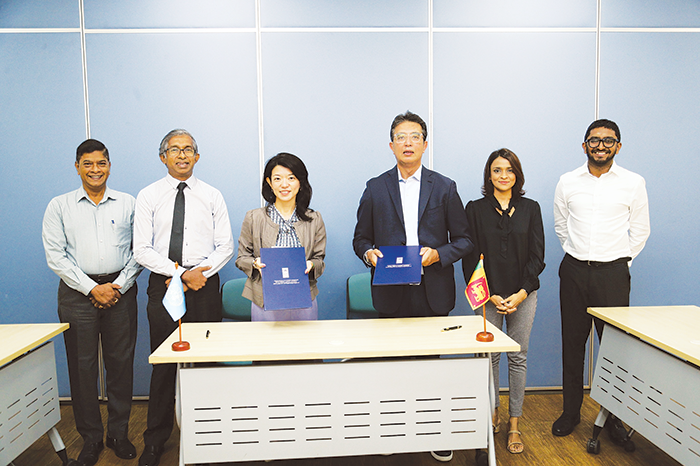
Hirdaramani Apparel, Lacoste Foundation contribute to empowering 100 families with increased income and nutrition supply Hirdaramani Apparel and the Lacoste Foundation have come together through the United Nations Development Programme (UNDP) in Sri Lanka’s facility for private sector giving to promote socio-economic recovery and food security and address its multidimensional vulnerabilities.
To signify the partnership, Vinod Hirdaramani – Chairman, Hirdaramani Apparel, and Azusa Kubota – Resident Representative of UNDP in Sri Lanka, engaged in a symbolic exchange of letters. Fadhil Bakeer Markar – Strategic Engagement, Digital, and Innovation Team Leader, UNDP in Sri Lanka, Buddika Hapuarachchi – Team Leader, Climate and Environment, UNDP in Sri Lanka, Damith Chandrasekara – Technical Specialist, Climate Smart Programme, UNDP in Sri Lanka and Imanthi Perera, General Manager – Corporate Communications, Hirdaramani Apparel were also in attendance for the occasion.
Speaking on the partnership, Azusa Kubota – Resident Representative, UNDP in Sri Lanka noted, “Towards achieving inclusive growth and building broad-based resilience in communities, UNDP gives utmost importance to working directly with vulnerable communities and families. In order to do so, we must work with multiple partners. Therefore, we deeply appreciate the valuable partnership with Hirdaramani Apparel and Lacoste Foundation to expand on the work spearheaded by the UNDP Private Sector Giving Facility, with a focus on economic empowerment of women for sustainable futures.”
Business
Sri Lanka’s economy at a crossroads: Fiscal improvement amid trade and demand woes

Sri Lanka’s fiscal health showed signs of improvement in early 2025, with the budget deficit narrowing to Rs. 86.6 billion in the first two months of the year, down from Rs. 129.3 billion in the same period last year. This was supported by a rise in government revenue and a decline in domestic borrowing, signaling cautious optimism in the country’s economic recovery.
Net domestic financing dropped to Rs. 96.8 billion, a significant reduction from Rs. 144.8 billion in early 2024, while foreign debt repayments continued, albeit at a slower pace. The Treasury bill and bond markets remained stable, with strong investor interest auctions were oversubscribed by 2 to 3 times. Foreign holdings of government securities also saw a slight uptick, reflecting cautious confidence in Sri Lanka’s debt instruments.
Meanwhile, lending rates edged lower, with the Weekly Average Weighted Prime Lending Rate (AWPR) dipping to 8.36%, supporting hopes of easier credit conditions. The stock market also saw modest gains, with the All Share Price Index (ASPI) rising 0.7% by early May.
Deflation persisted but softened in April 2025, with prices declining by 2.0% year-on-year – a slight improvement from previous months.
Food prices rose by 1.3%, while non-food categories continued to see deflation (-3.6%). Core inflation, which excludes volatile items, remained low at 0.8%, suggesting weak underlying demand.
Global oil prices fell amid concerns over slowing growth, particularly due to US trade policies, with Brent crude dropping by over $4 per barrel. However, Sri Lanka’s import costs for crude oil in March 2025 were slightly higher than the previous year, posing a challenge for energy-dependent sectors.
Export earnings grew by 5.3% in the first quarter of 2025, driven by strong performances in textiles, spices, and tea. However, import expenditure surged by 11.1%, led by machinery, oils, and dairy products, widening the trade deficit to $1.54 billion.
The Sri Lankan rupee depreciated by 2.3% against the US dollar this year, though the Central Bank bolstered reserves with 160.8 million in net foreign exchange purchases in April.
Gross official reserves stood at 6.53 billion by end-March, including funds from the PBOC swap arrangement.
While fiscal consolidation and stable debt markets provide some relief, Sri Lanka’s economy faces headwinds from global uncertainties and domestic demand weakness. The easing deflation trend and lower interest rates may support recovery but managing the trade deficit and sustaining export growth remain key challenges. In a broader context, the Central Bank figures depict neither a recession nor a boom. These figures suggest instead an economy grappling with persistent challenges and lacking clear momentum in either direction,” a source told The Island on condition of anonymity.
Reported using data from Central Bank.
By Sanath Nanayakkare
Business
Sri Lanka’s scenic South Coast emerging as a hotspot for digital nomads

WORX Co-Working leading the charge
As remote work continues to reshape global work culture, Sri Lanka’s scenic South Coast is emerging as a hotspot for digital nomads and WORX Co-Working is leading the charge. The country’s largest co-working network has just launched its fifth location, this time in the surfers’ paradise of Midigama, in partnership with Lime & Co Hostel.
Midigama, famed for its world-class reef breaks and laid-back vibe, is attracting a growing wave of long-term travellers and remote professionals.
Recognising this shift, WORX’s latest space blends productivity and leisure, offering high-speed Wi-Fi, 25 workstations, and an on-site Zippi café serving artisanal coffee, all just two minutes from the beach.
“Sri Lanka’s work-travel scene is evolving,” says Azahn Munas, Managing Director of WORX. “By partnering with Lime & Co, we’re creating spaces where professionals can work efficiently while enjoying the surf-and-sunshine lifestyle.”
The Lime & Co-Working space isn’t just about desks; it’s a community hub for workshops, networking, and pop-ups, catering to the booming digital nomad scene in the South. With Mirissa, Weligama, and Ahangama also seeing rising demand, WORX’s expansion signals a broader trend: Sri Lanka is becoming a top destination for location-independent workers.
Business
Ceylon Energy makes mark at Dubai Energy Expo

Ceylon Energy showcased Sri Lanka’s growing capabilities in sustainable energy solutions at the Middle East Energy Exhibition 2025 in Dubai, held from April 7-10.
The group’s Dubai arm, DH Ceylon Energy, drew attention with its keynote address by CEO Nalinda Ilangakoon, former CEB Chairman.
His presentation, “Sri Lanka’s Energy Transformation: Turning Crisis into Opportunity,” highlighted how the country converted energy challenges into innovative solutions through technology and partnerships.
A key exhibit was Ceylon Energy’s patented Helical Manufacturing Technology, developed with Hubbell Power Systems Inc. – making it the only producer outside the U.S. with this capability.
“Ceylon Energy is committed to sustainable solutions that serve both current and future generations,” stated Chairman Madusanka Fernando.
The participation underscores the company’s ambition to be a global player in energy innovation while positioning Sri Lanka as an emerging hub for green technology.
-

 News7 days ago
News7 days agoJapan-funded anti-corruption project launched again
-

 News7 days ago
News7 days agoSethmi Premadasa youngest Sri Lankan to perform at world-renowned Musikverein in Vienna
-

 Sports6 days ago
Sports6 days agoOTRFU Beach Tag Rugby Carnival on 24th May at Port City Colombo
-

 News4 days ago
News4 days agoRanil’s Chief Security Officer transferred to KKS
-

 Business7 days ago
Business7 days agoNational Savings Bank appoints Ajith Akmeemana,Chief Financial Officer
-

 Opinion2 days ago
Opinion2 days agoRemembering Dr. Samuel Mathew: A Heart that Healed Countless Lives
-

 Features5 days ago
Features5 days agoThe Broken Promise of the Lankan Cinema: Asoka & Swarna’s Thrilling-Melodrama – Part IV
-

 Features6 days ago
Features6 days agoTrump tariffs and their effect on world trade and economy with particular



